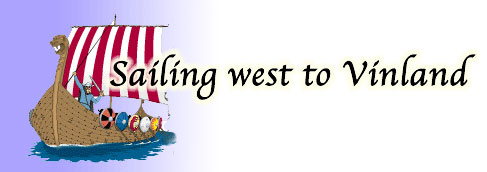Archaelogical finds in Iceland
 The
first men, considered to have searched for and gone on shore in Iceland,
are Irish monks. They described it as the island far in north, or beyond
the polar circle, and named it Thule. They were used to search for islands
in the northern seas at the end of 8. century and onto the ninth. Today,
no antiquities there have been found that indicate they lived here in Iceland.
If they actually were in Iceland, it would not have had any effects
on the vikings' known settlement, for the Irish monks were few, sought
solitude and thus lived isolated.
The
first men, considered to have searched for and gone on shore in Iceland,
are Irish monks. They described it as the island far in north, or beyond
the polar circle, and named it Thule. They were used to search for islands
in the northern seas at the end of 8. century and onto the ninth. Today,
no antiquities there have been found that indicate they lived here in Iceland.
If they actually were in Iceland, it would not have had any effects
on the vikings' known settlement, for the Irish monks were few, sought
solitude and thus lived isolated.
Eiríksstaðir (Eirikur
the Red's farm) in Haukadalur, has been rediscovered and rebuilt. But
it wasn’t inhibitaed for long, because it was small and mud-slides
occurred frequently. Right beside the house, a lady's bower has been
discovered , where the women did their work.
[The picture shows the very steps that Eirikur the Red and his houshold
walked on in the tenth century.]
Archaelogical finds in Greenland
The oldest evidence of Norse people staying in Greenland, are
to find in The Eastern settlement,
where Eirikur the Red built his house, Brattahlíð.
There have also been discovered ruins from the church of Thjódhildur,
Eirikurs wife. Age-analysis which were done on skeletons, found in the
graveyard, indicate of the time 976 ± 50 years. In the Eastern settlement
there have also been found ruins from around 400 farms. Similar researches,
done in The Western settlement
indicate that people lived there in the 11. century and there have been
found ruins of about 100 farms. Specialists who have numbered the Greenlanders,
believe they were around 2000, but do not agree. Some say they were up
to 6000, when they were the most (13. century). Yet, there have been found
no signs of heathendom, except for one blackstone (flint) with inscribed
the symbol of Thor (Thorshammer).
A few archaelogical finds, have been found in Sandnes, Greenland, which
prove that the Greenlanders went to Vinland; such as coals that are not
to be found in Greenland, but are found in Rhode Island, near Boston (the
east coast of USA). There have also been discovered arrow-heads from the
indians.
Archaelogical finds in Helluland (Baffin Island), Markland (Labrador)
and Vinland (North- America)
The year 1960, clear evidence of Norsemen living in the northern
tip of Newfoundland was found, in an area called L'Anse aux Meadows, by
Straight of Belle Isle. There were found ruins of houses, made of torf
and rocks and their buildingstyle was very similar to the style in Iceland
and Greenland, in the 10. century. The houses were three big camps
and few smaller.
The area is considered unique in Viking Culture, for the reasonof
it was not a settlement, but just a base for exploration. The Vikings used
it as a gateway to Vinland, which is a rather big land-area. The Vikings
are believed to have travelled to St. Lawrence-bay and to the north-east
part of New Brunswick, and collected many things from nature, such as grapes,
lumber and butternuts. They stayed on L'Anse aux Meadows, where no Indians
were threatening them, so the women and children were safe and the men
could do their explorations without fear. The camps, which were found
in L'Anse aux Meadows, are very likely to be Leifsbúðir (Leifur's
camp), where many Greenlanders wintered.
In Newfoundland, exploration on the coast of Epaves–Bay has been carried
out, and ruins of three houses have been found, and also a small smithy,
where nails were made from bog iron a thousand years ago.
Authors' small epilogue
*Christopher Columbus, is considered to have heard of Vinland, before
he sailed off  to
America, in 15th century. Though he is mentioned in connection to
America, he never actually set foot on the mainland. Some rather
obscure sources state that Christopher Columbus stayed one winter at Snaefellsnes,
Iceland, at the very farm that Guðríður Thorbjarnardottir
once lived. Maybe he heard bout the journeys of the Icelandic people
to Vinland and thus knew that some land existied far in west?
to
America, in 15th century. Though he is mentioned in connection to
America, he never actually set foot on the mainland. Some rather
obscure sources state that Christopher Columbus stayed one winter at Snaefellsnes,
Iceland, at the very farm that Guðríður Thorbjarnardottir
once lived. Maybe he heard bout the journeys of the Icelandic people
to Vinland and thus knew that some land existied far in west?
*Near Boston, USA, there has been found a coin from the days of King
Olaf (1066 – 93), in an Indian garbage dump, who lived by the Penobscot–creek.
Because of this information, we must ask ourselves; how far south
did the vikings really get?
*Researches on cats in Boston and New York, have shown more resemblance
to Icelandic country-cats than to other West-European cats. It is assumed
that those cats are the descendants of the vikings cats. They probably
ecscaped and procreated till today.

